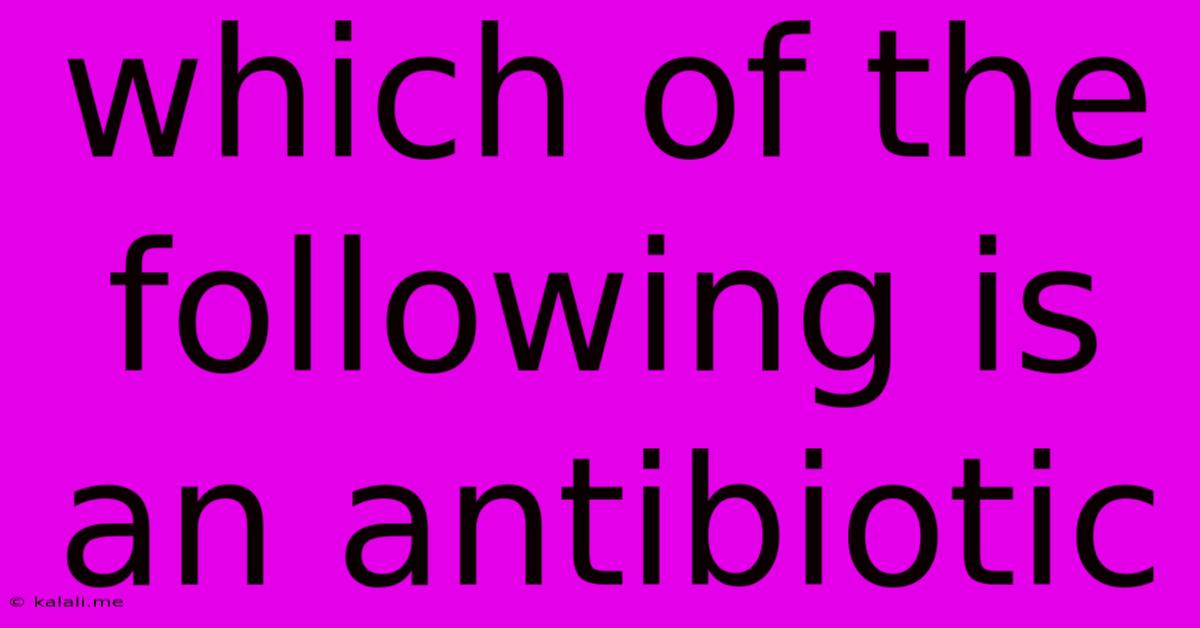Which Of The Following Is An Antibiotic
Kalali
Jun 14, 2025 · 2 min read

Table of Contents
Which of the Following is an Antibiotic? Understanding Antibiotic Classes and Their Uses
This article will explore what constitutes an antibiotic and delve into several examples to clarify the definition. Understanding antibiotics is crucial for responsible use and combating antibiotic resistance. We'll examine various substances and explain why some are antibiotics while others are not.
What is an Antibiotic?
An antibiotic is a type of antimicrobial drug used in the treatment and prevention of bacterial infections. Crucially, antibiotics target bacteria specifically, disrupting their growth or killing them. They achieve this by interfering with essential bacterial processes, such as cell wall synthesis, protein production, or DNA replication. It's important to note that antibiotics are ineffective against viruses, such as those that cause the common cold or influenza. Misusing antibiotics contributes to the development of antibiotic-resistant bacteria, a serious global health concern.
Examples of Antibiotics and Non-Antibiotics:
Let's consider some common substances and determine if they are antibiotics. The key characteristic to remember is the targeted killing or inhibition of bacterial growth.
Antibiotics:
- Penicillin: This is a well-known beta-lactam antibiotic, widely used to treat various bacterial infections. It inhibits bacterial cell wall synthesis.
- Tetracycline: Another broad-spectrum antibiotic effective against a wide range of bacteria. It inhibits protein synthesis.
- Amoxicillin: A semi-synthetic penicillin derivative, often prescribed for respiratory and ear infections. Like penicillin, it interferes with bacterial cell wall synthesis.
- Cephalosporins: A class of beta-lactam antibiotics with a structure similar to penicillin. They are used to treat a variety of bacterial infections, including those resistant to penicillin.
- Sulfonamides (Sulfa drugs): These inhibit bacterial folic acid synthesis, a vital process for bacterial growth.
Non-Antibiotics:
- Aspirin: A pain reliever and anti-inflammatory drug, aspirin is not an antibiotic. It doesn't target bacteria.
- Acetaminophen (Paracetamol): This common over-the-counter pain and fever reducer has no antibacterial properties.
- Ibuprofen: Similar to aspirin and acetaminophen, ibuprofen is an anti-inflammatory drug, not an antibiotic.
- Antivirals: These medications target viruses, not bacteria. Examples include acyclovir (for herpes) and oseltamivir (for influenza). While they combat infections, they are not antibiotics.
- Anti-fungals: These medications target fungi, a different type of microorganism than bacteria.
Choosing the Right Treatment:
It's critical to seek professional medical advice when dealing with any infection. A healthcare provider can correctly diagnose the cause of the infection (bacterial, viral, or fungal) and prescribe the appropriate medication. Self-treating with antibiotics without a proper diagnosis can be dangerous and contribute to the development of antibiotic resistance.
Conclusion:
Understanding the difference between antibiotics and other medications is essential for responsible healthcare. Antibiotics are specifically designed to target and combat bacterial infections, unlike other drugs that address pain, inflammation, or viral infections. Always consult a healthcare professional for diagnosis and treatment. The misuse of antibiotics has far-reaching consequences, highlighting the need for informed choices and responsible antibiotic stewardship.
Latest Posts
Latest Posts
-
Booting Is The Process Of Which Of The Following
Jun 14, 2025
-
Which Of The Following Is An Example Of A Solution
Jun 14, 2025
-
Heat Transfer By Convection Occurs When
Jun 14, 2025
-
Activation Energy Calculator With Two Temperatures
Jun 14, 2025
-
Brainstorming Is A Technique In Which Blank
Jun 14, 2025
Related Post
Thank you for visiting our website which covers about Which Of The Following Is An Antibiotic . We hope the information provided has been useful to you. Feel free to contact us if you have any questions or need further assistance. See you next time and don't miss to bookmark.